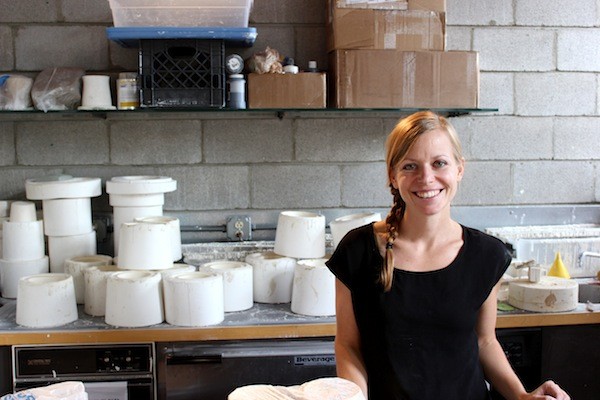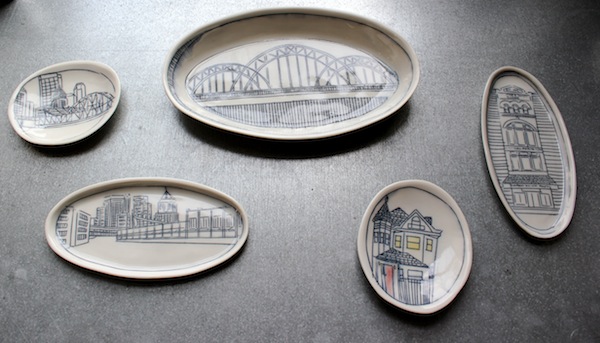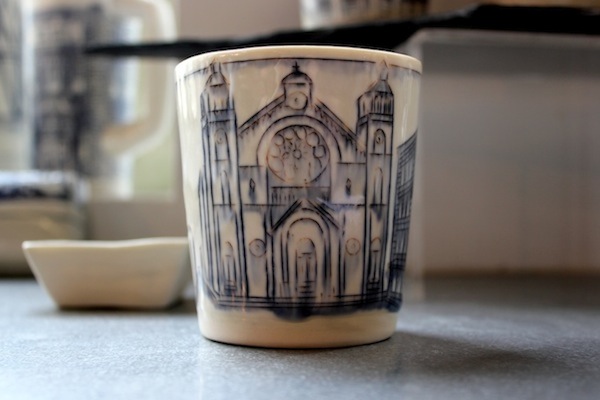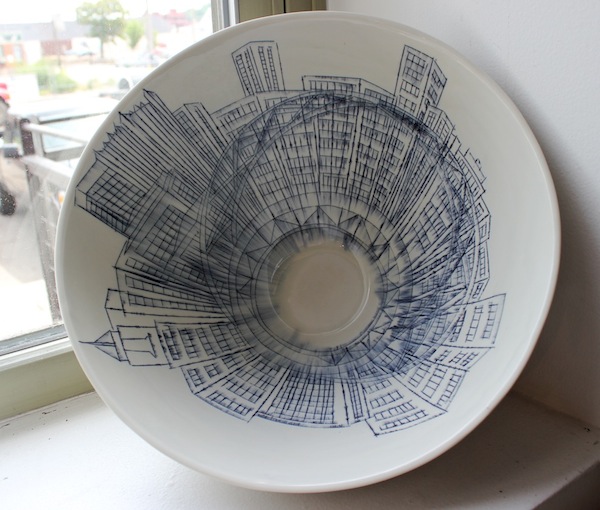Thomas Wolfe famously wrote, “You can’t go home again,” but Nicole Aquillano begs to differ. The 32-year-old Bostonite has returned to her hometown of Pittsburgh for the summer as the artist-in-residence at the Society for Contemporary Craft in the Strip District.
In many ways, Aquillano embodies Pittsburgh's newfound reputation as a haven for entrepreneurial individuals. She did her undergraduate work in math at Carlow University and in civil engineering at Carnegie Mellon. Then, after six years of work for the Environmental Protection Agency in Boston (during the final two she completed a master’s degree at the Rhode Island School of Design), she struck out on her own as a potter making usable art that is deeply rooted in place.
Aquillano's intensely personal work is now on display at the Society for Contemporary Craft, where you can also watch her at work, creating wonderful, watercolor-esque glasses, platters, vases and serving bowls featuring Pittsburgh landmarks.
We had a chance to sit down with the artist to talk more about her process, what she’s enjoying most about being home for the summer and how Pittsburgh has inspired her art.
Your background is in math and engineering, how does that inform your art?
Well for one thing, it’s what I draw. I’ve always been really fascinated by structures, which is why I think I became an engineer in the first place. It just wasn’t creatively satisfying to do calculations to find out how things will fall down. I was more interested in how they looked.
I also think it plays into my forms because usually I design my own forms out of plaster. It involves a lot of calculations because the clay actually shrinks 12 percent in the kiln. So I’ll calculate to see what size I actually have to make the mold.
Place is a subject matter that comes up frequently in your work. How did that interest factor into the medium you chose?
I’ve always felt very connected to my work and I think clay was a way to get that connection because it is so primal and it starts from dust basically. I mix my own clay and I spend a lot of time with the material, making the piece. I always wanted that to come across — my connection with the object.
I find it really awesome when someone else can connect with that object. I think that bringing in these specific places really helps strengthen that connection. I usually draw places that I have memories of and I’m really interested in that too — memories connected to object.
Tell us about the early phases of your work as an artist?
I did a lot of repetitive patterning. I think maybe it’s my engineering background that finds comfort in repeatability. It’s the way you solve problems. So I did a lot of repetitive markings and was looking at a lot of architecture because I’ve always been fascinated with structures.
When I started actually drawing the buildings, that’s when I felt that what I was trying to say came through. It was about place and connection and memory and it was me. I was pouring myself into my work. I never felt that was coming across until I started drawing places that are really important to me.
And I started to draw my home. I’ve always felt this crazy pull to come back home. When Janet [McCall], the director [of Society for Contemporary Craft], called me and asked, “Do you want to come home for the summer?,” I was sitting in my studio, thinking about how much I missed home, drawing the house I grew up in. I was like, this is fate!
I’ve never felt so right — I made the right decision so much.
What do you see down the road for your work? What are your dreams?
This has been really awesome because I always thought it would be great to do residencies in different cities and make art based on my time there, so this could be the jumping off point for something really cool.
Pittsburgh has become the quintessential place for people to leave a secure job and take the plunge into entrepreneurship. Do you think you took a piece of that with you to Boston?
[Starting my business] was the hardest choice I ever made. Having my husband really helped. He was very supportive and said, “What’s the worst that can happen? You have to get a job again.”
I think the realization that life is short is what really made me do it. And coming from Pittsburgh, I dunno I feel like there’s a certain amount of grit to the city. I feel like being from Pittsburgh definitely instilled that in me. It is a lot of work to make the switch from working for someone else to working for yourself.
What about Boston, how has living there informed your work?
It almost hindered it, because it’s so expensive and we live right in the middle of the city, so that was really scary. But, I have a really sweet setup where I’m in an artist live-work space. The whole building is full of artists and is zoned to support both living space and studio space. We have a duplex, so the first floor is my studio and the second floor is our home.
The Fort Point Arts Community is the only place I’ve lived — I’ve lived in a lot of different places in Boston — where I’ve felt like it was a community, where I know my neighbors. We do open studios two times a year; we have monthly meetings and a store that sells local artists' work.
What is it like being back in Pittsburgh?
It’s a little weird because I’ve made so much work about missing home, and now that I’m home, I’m starting to miss Boston. So maybe I just always want what I can’t have. It’s been good to mix it up. I’m still kind of absorbing it.
When you’re in Boston what do you miss about being in Pittsburgh?
I miss my family. I love Primanti Bros. and I really love Mad Mex too. When I come to visit from Boston over a weekend, I’ll go to Mad Mex twice.
Nicole Aquillano’s work can be purchased at the Society for Contemporary Craft through the 2014 holiday season. Aquillano will also be offering a workshop at the SCC on Sept. 6 where you can draw your favorite images of the Strip District in clay, which will be glazed and fired.








